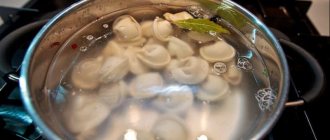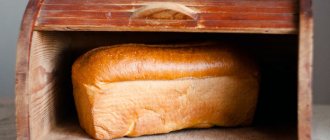Real Georgian churchkhela, made according to traditional recipes, can remain fresh for a long time. Such a product cannot be called perishable, provided that you are sure of its composition. In this article we will tell you what to look for when choosing how to store churchkhela at home and on the road.
Properly prepared churchkhela can be stored for 3-4 weeks.
What determines the shelf life?
Hazelnut churchkhela, prepared according to a traditional Georgian recipe, is not a perishable delicacy.
The shelf life of a product depends on several factors , but the key ones are the technology of preparation, drying, and transportation conditions.
When making factory-made churchkhela, manufacturers add a sufficient amount of lactose and nitrates.
Once the treat is ready, it is packed in a vacuum bag, due to which it is stored for a long period of time.
Classic churchkhela is prepared according to a traditional Georgian recipe and packed in paper bags or cloth.
Classic sweets are not stored as long as factory-made ones, and the shelf life depends on how correctly the production technology was followed.
Correct transportation
This product should be transported in a cooler bag. If you place it in a paper bag or a closed ceramic container, it will not deteriorate within 40 - 60 days. Those. during the entire permissible storage period.
If you are planning a long move, then:
- the sweetness is pre-dried well,
- then wrapped in dry natural fabric,
- after which it is placed in a clay vessel.
In this form, nothing will happen to her for 30 days. Even without a cooler bag.
If the temperature inside the container does not exceed +20°С -+22°С, churchkhela can move in it over a long distance without loss of quality.
But it is strictly forbidden to transport this product in a plastic bag.
What is included in churchkhela?
The components that the factory manufacturer uses in the process of preparing churchkhela are indicated on the vacuum packaging.
When making this classic delicacy, the use of preservatives, sucrose and starch is avoided.
The constant ingredients of the Georgian dessert include:
- ground Voloshsky and almond nuts, hazel,
- cherry, apple, grape or apricot nectar,
- wheat or corn flour.
Important! Eating churchkhela in large portions is strictly prohibited. Georgian sweets contain high-calorie components.
Kernels obtained from fresh walnuts are strung on a white thread, and the fruit juice is boiled and thickened with corn flour.
The thread with strung kernels is dipped into the resulting mixture and then dried for 2 hours. If necessary, churchkhela is soaked in nectar again, then hung in a secluded place and left for 7-14 days.
Be sure to read:
The main condition for storing yeast dough is to ensure that the baked goods are soft and fragrant.
To keep the treat for a long time, it is packed in a piece of fabric or cardboard packaging. The room where the sweets are stored must be free of moisture: this can cause the taste of the product to deteriorate.
Cooking it yourself - step-by-step recipe
step-by-step recipe for making churchkhela
When buying churchkhela at a market or beach, you cannot be sure of the integrity of the manufacturer, because the dessert for sale is usually made at home. Sometimes synthetic additives are used as thickeners, juices are taken not natural, but canned or from concentrates, and the quality of nuts leaves much to be desired (everyone knows that rancid old kernels, into which the oxidation process has destroyed PUFAs, only bring harm).
But a sweet prepared with your own hands, and even with invention and imagination, will allow you to fully enjoy the taste and therapeutic properties of the finished product. Many readers are concerned about the question of how to make churchkhela at home? You will only need patience, time and perseverance, because the delicacy must not only be prepared, but also properly dried in the sun, and for quite a long time.
We present to your attention an exquisite churchkhela product, a step-by-step recipe for which we learned at home from the chef of one of the famous Georgian restaurants. The main advantage of this recipe is its simplicity, so even a novice housewife can master it. Experimenting with ingredients and upgrading the process is encouraged!
You will need 10 low churchkhelas:
- freshly squeezed grape juice, red (all sweet varieties are suitable, for example, Isabella) - 2 l;
- mixture of sifted wheat flour, 2 grades, and finely ground corn flour, 3:1 - 0.65 kg;
- shelled nuts and/or seeds of your choice (hazel, walnuts, almonds, Brazil, pumpkin seeds) – 0.65 kg;
- harsh thread - 1.5-2 meters;
- a cauldron for evaporating juice with thick walls or a saucepan.
Preparation
The first step is to clean the nuts and seeds. Walnut kernels are divided into halves, the remaining varieties are used whole. They are strung on a thread, making each product about 0.25-0.3 m long. A knot is made on one side of the thread, and a loop is tied at the other end, from which the “icicles” will be hung for drying.
Nut dipping syrup
A viscous mass of evaporated juice with the addition of flour is called tatara or pelamushi. Freshly squeezed grape juice is poured into a thick-walled pan or cauldron, brought to a boil, reduced to a minimum, and skimmed off the foam.
When bubbles almost stop forming on the surface of the juice, pour 1/3 of the volume and cool. Pre-sifted flour is diluted in warm juice, adding it in small portions so that there are no lumps. It is more convenient to do this with your fingers.
While constantly stirring with a long-handled wooden spatula, pour the diluted flour mixture into the cauldron with boiling juice in a thin stream. The result is a thick mass, reminiscent of pancake dough in consistency. The tatara is simmered on the fire for some more time so that the floury taste and aroma completely disappears.
Drying
The juice with nuts is dipped into the juice prepared in this way. Make at least 3 approaches, each time allowing the remaining pelamushi to flow freely from the suspended products. To do this, place containers under the “icicles” in which the tatara is collected. The greater the number of dips, the thicker the layer of fruit mass is formed on the nuts, and the tastier your churchkhela will turn out, so don’t be lazy!
The finished churchkhela is hung in the sun for at least 15 days to dry completely. The products should not touch, and air should pass freely between them. At the same time, monitor the condition of the delicacy so as not to dry out the “icicles”.
Next, the delicacy is wrapped in parchment and stored in wooden boxes in a cool place, for example, in a cellar or basement. Most often, churchkhela is prepared during the grape harvest season and served on the New Year's table if children do not get to the amazingly tasty sweetness earlier.
How to choose fresh?
In order to store churchkhela for a long time, you need to follow the recommendations for its correct selection:
- It is strictly forbidden to buy churchkhela, on the top layer of which there are grains of sugar. This suggests that the cooking technology was not followed during its preparation.
- If the top layer of the treat is dotted with cracks, you should refrain from purchasing it. This indicates that excessive amounts of flour and sugar were used in its production.
- In order to make sure that the treat is not “rubbery” , when purchasing it, it is recommended to bend the protruding thread.
The best option is to purchase freshly prepared churchkhela and dry it yourself.
A finished, high-quality product must have a soft interior and a dried out crust.
How to properly store at home?
Damage to churchkhela in most cases can be caused by the formation of mold.
The nutrient mass of flour and fruit juice promotes the rapid development of microorganisms, especially if a warm and humid room was chosen to store the sweets.
To successfully preserve oriental delicacies, it is important to comply with the following conditions:
- a little ventilation in the room and dry air,
- the room temperature should fluctuate between +15…+20 degrees.
You need to store sweets at home in rooms with good ventilation.
Churchkhela must be wrapped in breathable gauze or thin paper that absorbs moisture and protects the product from dust and pests.
Can it be kept in the refrigerator?
In ancient times, churchkhelas were not stored using additional cooling. But with the advent of refrigeration units, many people wondered whether it was possible to store delicacies in the refrigerator.
Be sure to read:
Quail eggs: terms and storage conditions
This is not a prerequisite, but if you wish, you can keep the product in the refrigerator.
Storing churchkhela in the refrigerator can prevent the formation of mold, but at the same time it increases the risk that the delicacy will dry out faster.
The product should be wrapped in a piece of gauze or thin paper and then placed in the refrigerator. It is strictly forbidden to freeze freshly prepared sweets.
How long does it last at room temperature?
If suitable conditions have been created for storing the oriental delicacy, the product can last for quite a long time. The drying of the crust can only be noticed after 30 days: then it will be difficult to chew the churchkhela.
In order to soften a dried treat, you need to place it next to flour products (loaf or bun). Baked goods will soften the sweetness.
Methods for softening hardened crust
What to do if the churchkhela has already dried out a little? There are several ways to restore its softness, but only if the product has not been spoiled, otherwise digestive problems may arise.
You can soften the dried sweetness by placing it in a sealed container next to fresh bread, and then the churchkhela can become a little softer, absorbing the moisture evaporated by the baked goods.
Or hold the hardened treat over steam and then consume immediately. You can also use the microwave to warm up the juice crust for a short time.
How can you tell if it has gone bad?
It is quite easy to determine that churchkhela has become unfit for consumption . This can be understood by the consistency of the product and its appearance.
A spoiled treat may contain mold, which is not always visible on the surface. Before you eat churchkhela, you need to break it and carefully examine it for the presence of fungus.
If the product has a wet surface, a softened crust that is falling apart into pieces, you should stop using it. This indicates that the storage conditions were violated or the production technology was not followed.
Signs of product spoilage
If the conditions are incorrect or the storage period has expired, the dessert may spoil. Signs of damage:
- the appearance of mold - a white layer on top of the treat;
- the dessert does not hold its shape and quickly falls apart;
- the surface of the treat has become wet and sticky;
- unpleasant bitter taste and smell.
When purchasing a Georgian national delicacy, be sure to look at the production date. If it is not there, then you need to find out from the seller when the sweetness was produced. If the product looks dubious, and the seller finds it difficult to answer the question about the exact production date, then it is better not to buy churchkhela from him.











